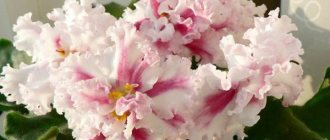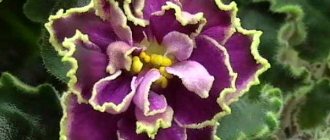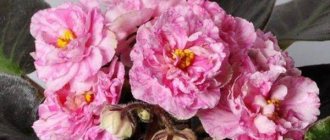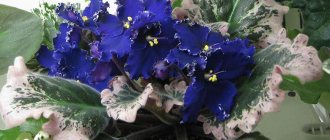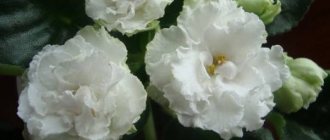Violet is a houseplant that almost no one knew about 50 years ago. Today, in the course of breeding work, numerous varieties of this amazing ornamental crop have been introduced. Among all the variety of violets, gardeners distinguish the “Black Pearl” variety. It is distinguished by its incredible beauty of flowering and easy care.
Dear readers! For you, we have created communities on social networks in which useful articles and interesting ideas are published several times a day! Subscribe and receive useful content in a convenient format!
Description
Black Pearl is a variety of violets that is perfect for experienced gardeners or hobbyists. It is distinguished by long and bright flowering , which once you see, you will not remain indifferent.
History of the variety, who bred it
This variety of violet was bred by the famous breeder E. Korshunov.
Leaves
The leaves of the plant are dark green, both on the outside and on the inside. Their surface is velvety.
Flowers
Violet flowers are simply impressive in their size, as the diameter is 7 cm.
But during flowering, the flowers gather in inflorescences-a cap, as a result of which it is simply impossible to take your eyes off the plant.
Features and differences from other varieties
The “Black Pearl” violet differs from other species in that it has large double flowers. They have a purple color with a noble velvet tint. In addition, the flowering of the plant can be extended if you follow all the rules of agricultural technology.
All about watering
This plant came to us from the wild. The first flowers were brought from the mountainous regions of Kenya. For comfortable growth, it, like the bred varieties, needs a lot of light, but in direct sunlight it will quickly die, so it is extremely important to find a suitable place. In the wild, violets are found along river banks and near waterfalls that irrigate the ground with water spray. Often favorite places are in partial shade, under trees. That is, in addition to lighting, it is very important to solve the issue of soil and air moisture. Experienced flower growers have found a very successful way, thanks to which the “black pearl” violet blooms for many today (we provide a photo in the article). Even when planting, a thick soft thread is threaded through the drainage hole (pure wool is not suitable, nylon is better). It should be long enough.
The upper part is located in the soil, almost to its very edge. The lower part hangs freely from the drainage hole and is placed in a vessel of water, which stands under the shelf with violets. In this way, two goals are achieved at once. The air is moistened due to evaporation, and water flows through the thread into the soil. The possibility of overwatering and drying out, which are detrimental to delicate varietal plants, is eliminated.
There is another option. Take a wide tray and fill it with large pebbles. Now fill it with water so that it does not cover the stones, and place pots of violets on top. The rope will freely transport liquid into the soil, and the air will be constantly humidified.
Photo of violet EK “Black Pearl”
Replanting after purchase
If you purchased an adult plant or a baby plant, then they need to be replanted immediately, since the soil may be unsuitable. Choose a container that is approximately 2 times smaller than the outlet. If we are talking about children, you can take 50 ml plastic cups (for example, for children's cottage cheese).
Transplanting violets after purchase
You must make holes at the bottom. Next, expanded clay is poured in and covered with earth.
Note! The violet should be in the container at such a level that the midpoint of growth rises slightly. Place the rosette in the middle and carefully add soil to the sides. Lightly compact
Lightly compact.
Growing conditions
The growing conditions for this variety are listed below.
Priming
The plant variety in question is popular because, if you follow simple care rules, the plant can delight others with its flowering throughout the year. It is very important to choose the right soil mixture. Use light and loose soil. This will saturate the root system with oxygen. At the same time, the soil must retain moisture well.
Attention! If you do not want to buy ready-made substrate in a specialized store, then you can prepare it yourself. To do this, take components such as peat, leaf, turf and coniferous soil. Dilute the resulting mixture with river sand.
Pot
It is necessary to grow the “Black Pearl” violet in pots whose height and diameter are 10 cm.
Moreover, ½ of the lower part should consist of drainage. Until the roots fill the container with soil, the violet will not bloom.
For breeding, the first pot can be 6 cm in diameter. In this case, the drainage hole should be large.
Lighting
In order for the violet to fully grow and develop, it is necessary to provide it with adequate lighting. To do this, keep pots with plants on the windowsill. Just make sure that direct sunlight does not penetrate it.
Temperature
To grow this variety of indoor plant, it is necessary to maintain a temperature regime of 20-24 degrees. If the temperature is 20 degrees, then adult specimens will bloom for a long time, and the flowers themselves will be large. For young plants that have just been separated from the mother leaf, it is worth setting the temperature regime to 23-24 degrees.
Humidity
Suitable humidity for violets remains 60-70%. If you exceed this figure, the crop may get sick and die
How to care for a violet so that it blooms?
Different types of violets still require special approaches to caring for them:
Wild ones choose their own conditions. More than 500 of them are known in nature;
- For gardeners, it is necessary to take into account natural features. They are often called “Pansies”;
- And for indoor ones, your task is to create acceptable conditions. These are hybrids of Uzambara violet. But the conditions are not so difficult and insurmountable.
Most types of violets grow naturally in temperate climates. So at home, similar (approximate) conditions are suitable for them.
Just one opinion from a person in love with violets. “I’ve been collecting violets for more than 10 years. I grew many varieties. I left only 150. All are beautiful. But I am fond of large-flowered plants. For some, idols are miniature. Or variegated. Interests are different. And some people just take what they have. And he is not deprived of even such a choice.
And further. Violets feel related to them. If you don’t really like the variety, it won’t bloom well for you. The flower you like will bloom brightly. Not only because of good care. But because of your attitude."
And yet, be more specific about violets. How to properly care for them to bloom profusely:
- Good lighting, but without direct hot summer sunlight;
- Temperature is moderate. 23-25 degrees is enough for them. But not higher. And not lower than 15-16 degrees;
Select suitable modes and methods of watering. You can't overdo it;
As with fertilizing. Keep an eye on your flowers all the time. Different conditions, periods, seasons determine the quantity and methods. There are other nuances.
Planting and propagation
The Black Pearl violet reproduces by leaf.
To do this, you need to cut the leaf stalk with a sharp knife at a sharp angle. The length of the cutting is 3 cm. Water can be used to root the leaf. Pour it into a plastic or glass container, place ½ tablet of activated carbon there, and then install a leaf.
When the length of the root system is 1.5-2 cm, plant the leaf in peat, deepening it by 1 cm with an inclination of 45 degrees. Water thoroughly, cover with polyethylene and place in a bright and warm place.
Rooting of the leaf occurs within 2-4 weeks. Babies are formed in 1.5-2 months. All this time the leaf should be under polyethylene. Perform airing once a week, opening the film for 1-2 minutes. As soon as 2-3 pairs of leaves are formed on the children, then plant each one in separate containers, the diameter of which is 6-7 cm.
Articles about other varieties of violets: “Southern Night”, “Sea Wolf”, “Chateau Brion”, “Dance of the Galaxies”, “Goddess of Beauty”, “Angelique”, “LE Isadora”, “Duchess”, “Winter Smiles” and others.
N-Pearl
Selection N.D. Berdnikova, 2012. You can see a photo of the violet N-Pearl below.
Description
The violet is classified as a miniature type. The variety produces a small, symmetrical rosette with a slightly broken outline. Miniature leaves of a rounded-pointed shape are painted in a rich green color with a magnificent white edge with a pinkish tint along the contour.
The variegated color appears with greater intensity at the center of the rosette and can fill almost the entire leaf, while the lowest leaves are completely without variegation.
The flowering of the variety occurs with the rapid formation of buds, and due to the long peduncles, a scattered bouquet is formed.
A characteristic feature of violets are simple white corollas with 4-5 petals.
Some specimens may exhibit a pink tint to the flowers.
Features of maintenance and care
- the variety is characterized by rapid growth and undemandingness - suitable for gardeners with little experience;
- like all variegated violets, “N-Zhemchuzhinka” needs cool keeping to preserve the decorativeness of the leaves - the variegation disappears in the heat;
- When fertilizing, you cannot use a lot of nitrogen, as it enhances the production of chlorophyll, which means it reduces white spots on the leaves.
Care
Care includes simple procedures listed below.
Watering
And although this plant variety responds positively to watering, you should not be too zealous.
Irrigate plants only with warm and settled water. When watering, do not allow water to get on the leaves, so it is best to water through a tray.
Spraying with a spray bottle is another great way to humidify as it will force water into the outlets.
Transfer
If the violet has stopped growing, then it is necessary to prepare a new pot, the diameter of which will be equal to 1/3 of the diameter of the rosette. The substrate also needs to be replaced. Since the root system of the plant is poorly developed, it should be replanted together with a lump of earth. Transfer the flower to a new pot and add substrate. All that remains is to water.
Fertilizer and feeding
The Black Pearl variety is sensitive to the composition of the soil.
If you do not fertilize, the plant will develop greenery and stop blooming. To saturate the soil with necessary microelements and substances, it is necessary to apply fertilizer once every 2 weeks.
Make sure that the concentration of the solution does not exceed 2 g per 1 liter of water. To protect the plant from fungal infection, treat the soil with a weak solution of potassium permanganate.
Diseases and parasites
The “Black Pearl” violet is extremely rarely affected by parasites and diseases. This occurs mainly due to non-compliance with the rules of agricultural technology.
Table 1 - Flower diseases and treatment methods
| Disease | Symptoms | Causes | Treatment and prevention |
| Powdery mildew | It damages leaves, petioles and peduncles in the form of a whitish coating. | Poor lighting, low temperature, high humidity, lack of potassium, nitrogen. | Treatment with Fundazol or Bentlan. In case of massive damage, treat the plant every 10 days. |
| Late blight | Root collar rotting, brown spots on leaves. | Inadequate care. | Remove affected plants, sterilize the hills, and treat the soil with superphosphate. |
| Gray rot | Fluffy brown-gray coating on leaves, stems and flowers. | Drafts, sudden changes in temperature, waterlogging of the soil. | Remove the affected parts of the plant and treat the crop with a fungicide. |
| Fusarium | The petioles of the leaves are affected by a brown coating, the leaves fall off, and the root system darkens. | Excessive waterlogging, temperature changes, use of cold water for irrigation. | Remove the affected parts and treat the crop with a fungicide. |
| Rust | Yellow-orange tubercles on the outside of the leaves. | Temperature changes, excessive watering, drafts. | Treatment with 1% Bordeaux mixture or fungicide solution. |
Table 2 - Violet pests and their control
| Pest | How to recognize | Fighting methods |
| Mite | The leaves are covered with depressed brown spots. | Treatment with Akarin, Actellik or Fitoverm. |
| Shchitovka | Affects rosettes with smooth leaves. Forms a sticky coating. | Treatment with Agravertine. |
| Thrips | They violate the integrity of the stamens, forming silvery nibbles on the flowers and brown spots on the leaves. | Remove affected plants along with the soil. |
| Aphid | It feeds on the sap of the plant, forming a sticky liquid on the leaves and peduncles. | Perform 2-3 treatments with Actellik (1 ml of product per 1 liter of water). |
| Woodlice | They damage the roots and leaves of violets, causing secondary infections. | The plant is sprayed and the soil is watered with Actellik or Fitoverma solution. |
RELATED MATERIALS
5
10
All small-fruited citrus fruits are highly ornamental plants and are ideally suited for...
5
What is the secret of the popularity of Saintpaulia and why our grandmothers grew Uzambara for years...
5
One legend says that eucalyptus will help with almost all diseases. But probably …
4,75
3
Is it possible to grow a coffee tree at home? Many people ask this question. We answer: “Yes!” ...
4,6
22
The anthuriums we grow at home come primarily from humid equatorial forests...
5
5
Old gardening books say that fuchsias and pelargoniums are not indoor plants, they are grown...
4,8
1
The variegation of Saintpaulias is due to the absence of green pigment in certain areas of the leaves...
What flower are you based on your date of birth?
Follow our updates! And soon the calendar will be compiled...
Gardeners and flower growers are people too, they love and give new varieties names that are dear to them. And we can...
